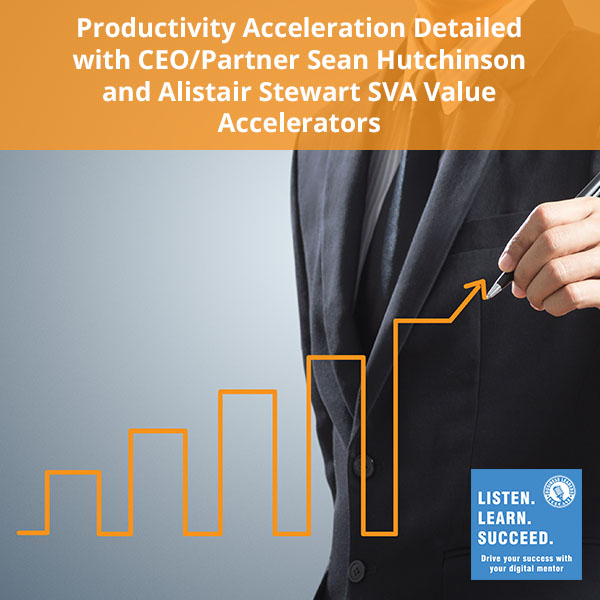Productivity Acceleration Detailed with CEO/Partner Sean Hutchinson and Alistair Stewart SVA Value Accelerators


The reason all owners are in business should be primarily to create value for themselves. The way they create value for themselves is by creating value for customers. One way to do that is by productivity acceleration. Productivity is accelerated by understanding non-value-added activities and stop doing them. That frees up a tremendous quantity of resources, time, cash, and physical space to focus on delivering customer value. This is a deep dive continuation with Sean Hutchinson, CEO/Partner with SVA Value Accelerators and Alistair Stewart, the Manufacturing Practice Leader, also with SVA Value Accelerators. This continuation is where we’re going to dig deeper and talk about productivity acceleration.
—
Productivity Acceleration Detailed with CEO/Partner Sean Hutchinson and Alistair Stewart SVA Value Accelerators
Creating The Path To Higher Valuation with CEO/Partner Sean Hutchinson and Alistair Stewart
This is a deep dive continuation with Sean Hutchinson, CEO/Partner with SVA Value Accelerators and Alistair Stewart, the Manufacturing Practice Leader, also with SVA Value Accelerators. This continuation of the episode is where we’re going to dig deeper and talk about productivity acceleration. I appreciate it. Thanks so much for taking the time.
Thanks. It’s great to be with you.
Let’s talk a little bit about what productivity acceleration is. We can think about productivity as the effectiveness of the productive effort. It’s measured by the rate of output per unit. What does accelerating mean? That means making it happen quicker. The reason all owners are in business should be primarily to create value for themselves. The way they create value for themselves is by creating value for customers.
Here’s an example. Imagine that an owner staples a new order to their back, the next customer order…every time they shake somebody’s hand, every time they meet somebody, every time they wait for somebody, every time they wait for something, every time something has to go back to be redone, checking and rechecking all those activities, are what we call “non-value-added” steps. If you start to look at the operations of a typical company, and most owners are going to be shocked if they are reading this for the first time, about 95% of all activities do not create customer value.
To create customer value, an activity has to pass a classic three-part test. An activity, has to be done right the first time; It has to change the form fit or function if it’s a tangible product or has to deliver a service that otherwise wouldn’t happen or it has to convert data into information or knowledge, changing the form fit or function of something.
The last and best of the three parts of the acid test is the customer must be willing to pay for it. Again, imagine a hypothetical owner stapling him or herself to an order that halfway through that order has to go back to the preceding step because we are missing some information. We’re not exactly sure if the customer wanted it in blue or in black. We go back and we find that the sales guy wrote down B in the color box. That was all non-value-added activity. We’re going to break that out as a line item on the invoice to the customer. Checking what color you ordered. You told us loud and clear what color you ordered. We didn’t understand. We didn’t write it down. We didn’t record it. No customer is going to pay that. All of these little activities that are pervasive in every organization are death by a thousand cuts, and productivity is hurt..
Productivity is accelerated by understanding non-value-added activities and stopping doing them. That frees up a tremendous quantity of resources, time, cash and physical space to focus on delivering customer value. Think about the activities that don’t change the form, fit or function of the product, aren’t done the right first time, and the customer would be unwilling to pay for if he or she saw them as a separate line item on the invoice. As we think about all the roughly 95% of the time that’s dedicated to non-value-added activities, we can see that those non-value-added activities can be classified into eight types of waste..
I’ll run through them in short order. There’s a great acronym that people can use to remember them. The acronym is DOWNTIME. I’ll go through each of the classic eight wastes.
First is defects. Making something out of plastic that we either scrapped, or redid. The worst kind of defect is one that makes it to the customer. Even if that defect is detected internally and something is either scrapped or reworked, that’s still a waste. Don’t confine our thinking to tangible products. There are many information defects that occur throughout many organizations.
The next kind of defect is overproduction. We make stuff that hasn’t been ordered. What do we do with that stuff that hasn’t been ordered? It sits on a shelf somewhere. We’ve got to have a shelf for it to sit on. We have to insure the space that the shelf’s in. We have to insure the stuff that’s on the shelf all due to overproduction. That is working capital not available for productive use.
The next of the wastes, that’s waiting. If we’ve overproduced and something’s hanging around, it’s waiting. Or f I’m downstream from Sean, Sean is taking longer than anticipated to complete his activity and I’m next in line, what am I doing? I’m waiting for the product that Sean is working on.
The next of the wastes–and I believe as do most people who have studied and used this approach–is the worst of all: non-utilized talent. If we harness the creative and physical capabilities of everybody on our team, we’ll start to accelerate productivity. Just because you’re the newest hire in customer service with six months’ work experience out of college doesn’t mean you don’t have a great sharp, curious mind.
The next of the waste is Transportation, moving stuff around. We can think of this classically in a manufacturing facility, but we also can think of it in terms of email. Shuffling documents back and forth. It’s very corrosive because we don’t think about the time it takes to move information, take a look at it and get back to it. Why are you moving that information around? It’s getting a second opinion. You’re asking somebody to check something.
There is an interesting example of that we all get frustrated by, which is… the document gets emailed to eight people. There’s no clear instruction about who’s supposed to review it and who’s supposed to get back with comments on it when it probably could have gone to one person without the copies to the other seven. That person reviews it and comments on it. There’s the question of “did it have to happen that way if it had been done right the first time?” Nobody would have had to review it.
If we harness the creative and physical capabilities of everybody on our team, we’ll be starting to accelerate productivity.
As we move through this concept of value-stream mapping, we’ll identify who needs to get something downstream and who doesn’t.
The next of the wastes is inventory. If we have inventory hanging around, that is working capital that is unavailable for other productive uses, for example, being applied to innovation.
The next of the wastes is the concept of motion. This comes more from a manufacturing perspective but on the shop floor, moving your hands, your body leads to all kinds of ergonomic challenges, maybe not as relevant in the virtual world, the virtual economy. It certainly has a role as a waste in a service industry where there’s a physical delivery of something.
The final waste is excess processing. Painting the inside of a machine housing. Nobody is looking at the inside of that housing.
That’s an example from a physical, tangible world. We can also think of excess of processing in the design phase of anything. Am I doing more than is needed for the customer? That might mean I don’t understand customer requirements.
Eight classic wastes of business activity that contribute to 95% of the hours. Imagine if my boss is looking to get 40 solid hours from me every week. If I’m in a typical company, I’m spending 38 of those 40 solids on non-value-added activity. That is stunning, and should get the attention of every business owner. Stop doing the non-value-added activities, which allows us to focus on value-added activities.Productivity goes through the roof.
How do we understand these wastes? How do we see them? An easy way of learning to see classic wastes is through a technique known as value stream mapping. It’s laying out in sequential order a picture that shows the discreet activities or operations that go on and some data to characterize each operation. What is the standard cycle time for an operation?, If you’re in the banking sector, You could think of this in terms of originating a loan.
Processing a mortgage.
It doesn’t have to be just the physical world. We lay out the sequence of activities for each operation that’s involved. What’s the standard cycle time? How many people does it take to do it? If there’s some piece of equipment, a database, a computer, a machine, a truck. Anything that we need to do the work isn’t always a machine. Is there set up that needs to be done? If I’m doing a step in processing a mortgage, I probably have to go and get some kind of credit information. What does it take to have all the available pieces of data so that I can now submit that credit application? Lord forbid we might be missing one critical piece of information, which means we have to go back, all the delays and so on that are involved.
 Productivity Acceleration: The worst of all the wastes is non-utilized talent.
Productivity Acceleration: The worst of all the wastes is non-utilized talent.
This idea of value stream mapping helps us identify how value flows through an organization from the receipt of an order, shipment or delivery of the service or product. When we can visually see it, we can start asking ourselves, “Is that activity needed? Is it adding any value? Where are these eight wastes? What can we do? Most importantly, what can we do to get to get rid of them? As we think about eliminating unnecessary activities and reducing or mitigating wastes in other activities, we’re accelerating throughput. Henry Ford in 1926 took the assembly time for a vehicle from thirteen hours to two and a half hours.
If something that takes you thirteen hours to do, and we can get it down to two and a half hours by eliminating waste, people might be skeptical. There’s a track record for decades of applying these classic tools, these classic methods to eliminate waste and free up so much capacity to create customer value. When you create more customer value more quickly, you’ve got a stronger competitive advantage and you’re more profitable.
We can also think about throughput as being revenue. If you believe in Dr. Goldratt’s Theory of Constraints approach to running a business, there are only three metrics to solve for and they’re throughput, inventory, and operating expense. The idea of “stop doing the non-value-added activities” in order to accelerate throughput is fundamental to being a highly effective business person.
Sean: I saw you do a value stream mapping exercise once that I thought was interesting. The visual aspect of this is crucial for people to be able to see it. What you did was brilliant in its simplicity. We had a management team in the room. We drew six lines on a whiteboard. Those lines, the space in between them represented what were called swim lanes. Those swim lanes represented either a department in the company or a functional area of the company. For each step along the way, we put a sticky up there and we wrote what the step was. Someone touched a physical thing or something was happening in the company. We put the sticky note in a swim lane to assign it to the operations area or the finance area, so on and so forth. You could very easily see the different activities that were happening and also where they were being performed in the company
What I found fascinating about that exercise, besides the work that went into it, was that people were discovering things as they went. Go back to the example of stapling a customer order to your back and walking it through the organization. That was what was happening. There was a crucial question. Who touches it first when it comes in? Who’s the person that receives it? I watched that group struggle probably for 30 to 45 minutes to identify step one because everybody kept saying, “That’s where it starts, and then somebody else would say, “No, there’s a step before that.” And we would move the note or put up another one.
Once you got them up on the board, you’re looking at it and there are 70 steps. All of them representing tasks, it’s a pretty crowded board. We can now ask , “Is that necessary? No, it’s not. Rip it off the board.” Until eventually the happy path in that particular process emerges from the first step to the last step. You go from 70 stickers on the board, to 50 on the board, maybe less. What Alistair was saying is you can make a big jump just by eliminating 10% or 15% because everything that happens when you free up those unnecessary steps converts to not just to the financial performance of the organization but the line on the organization’s balance sheet that’s always at the top, cash-on-hand.
Necessity is the mother of invention.
If an owner is thinking” we’re doing better but my cash is burning up. I’m growing but my cash is disappearing. What’s happening?” You can point right back to gaps in productivity, gaps in throughput, or constrictions on throughput. If you look at it visually, you’re going to be able to begin to find those things.
Here’s the intimidating part of value stream mapping. That particular exercise was about an invoice coming in the company and an invoice being paid. How long has that taken us? It was taking a long time.
Once an invoice is in the company, there are probably only three or four steps until somebody writes a check. I found that to be fascinating to watch it happen in real time with real struggles. Magnify it to 100 or more crucial processes that are similar We need to map every single one of those and look for potential gains in productivity.”
In our value accelerator, by the time we get to productivity, we have a very clear vision of the Company in the Future because that’s the sprint that precedes it. Now we have clarity on where we want to go. If we didn’t do that first, it’s very possible to focus on solving the wrong problems.
Let’s imagine that there are productivity problems on the shop floor, in manufacturing. We can see that there are productivity problems in one production line for one product that the company is making. The company allocates a significant amount of money to correct the problem and sends the team out on the floor to improve that product, to improve that piece of their throughput.
If, after that, they do their strategy work, their company of the future work, they get clarity on the fact that the product didn’t do anything to produce value for the customer or for the company. It’s taking a lot of capital. If we trace it all the way through, we’re getting no shareholder value out of it. Now we’re going to starve that. We’re going to redirect that capital to another higher value activity.
Now, somebody walks out from the management and says to the shop floor team, “Take that line down, we’re not doing it anymore.” The person says, “We spent $500,000 improving the throughput for that product. Do you think you could have figured out before we did that we didn’t need to? We could have put that $500,000 over here into something of higher value.” It’s important to have clarity on strategy. Otherwise, you’re funding things that you’re probably not going to get any value out of.
 Productivity Acceleration: Have a very clear vision of the company in the future because that’s the sprint that proceeds productivity acceleration.
Productivity Acceleration: Have a very clear vision of the company in the future because that’s the sprint that proceeds productivity acceleration.
It’s important to have everybody in the organization aware of what we’re doing to accelerate productivity. We can make tremendous gains, let’s say 0n the shop floor, to get more productivity; unless we have orders to take advantage of the capacity that we have liberated by eliminating activities, reducing non-value-added activities then there’s no more cashflow. It’s absolutely vital that, for example, the sales and marketing organization are part of the productivity acceleration conversation.
If sales increased demand, we enter a virtuous cycle of creation. I’ll use a manufacturing example. It’s true in service. It can be true in retail. It’s true in distribution. Imagine that we and our competitors have trained our customers, have trained the market to accept a seven-week lead time for our products. We look within our operations from beginning to end. We identify where the choke in throughput is. We recover or add capacity at the chokepoint, which causes the choke to move somewhere else. A relentless focus on this brings our lead time down from seven weeks to five weeks. Inherently our unit cost is lower and generally speaking, customers will pay a premium for shorter lead time.
If we don’t have sales and marketing in the conversation about productivity gains, we may not have anywhere to go. If sales and marketing are with us, a couple of things are going to happen. We’re going to communicate our greater value to the market by having a five-week lead time compared to everybody else’s seven-week lead time. We will adjust prices to reflect that incremental value. We have this virtuous margin expansion going on where we’re charging more and realizing a higher price and the unit cost is lower because it’s taking us less time. We’re making more of them because of the productivity gains that we realized. We could only do that with a relentless focus on understanding where the chokepoint is and recovering or adding capacity to it, and continuing to rinse and repeat to address other chokepoints in throughput.
That’s an important point: you have to have the demand in some ways to justify the investment in productivity. Bringing in sales and marketing and also market intelligence, competitive intelligence, what kind of data are you getting that would support the idea that you’re going to get more into your channel, into your pipeline. Being able to expand the size of the throughput is absolutely necessary in order to take that demand and convert it into cash in a reasonable amount of time. That’s what we’re talking about. At any time you can open up those choke points. If you think of it literally as a pipe, you can only push so much through. If you’ve got a narrow pipe, you’re going to have to figure out a way to make it bigger.
Complacency, as we know, is business death.
My understanding of Henry Ford is he didn’t just decide one day that he wanted to make cars in a shorter period of time. That’s a neat idea. But he actually had to. This goes to necessity is the mother of invention in a sense. He knew that demand was coming. He was in the middle of a real problem, which was a lot of people in the United States wanted that car. He couldn’t make it fast enough if it was at thirteen hours. There was no way that he could meet the demand. What did that do? One, if you didn’t figure out how to do it, he was opening the door for a competitor to figure it out themselves and step into the gap. He didn’t want to provide any toe in the door for one of his competitors to make it faster and meet the demand that had emerged, that he had created in a way by manufacturing this first early stage automobile.
The other people were seeing that the demand too. It was no secret. They’re going to go start car companies. They’re going to start making a better car. How does he keep them at bay? He figures out how to make the car faster. He challenges them to catch up with Ford. It’s a hard thing to do. This is what made that situation legendary. Creating demand, he did it well on the front end. He was innovative. He knew what to invest cash up, where to tie up his cash. He acted proactively in some ways too, “I’m going to see a huge demand for this vehicle in the United States. I better figure out how to make it better.”
To build on necessity as the mother of invention. At the end of the Second World War, Japan’s industrial capacity and capability had been tremendously impaired. In the United States, all the GIs came back and we had a couple of decades of tremendous gains in prosperity. A blue-collar working-class guy could have a great life, provide very well for himelf and his family. Japan, as they were rebuilding, necessity was the mother of their invention. When we saw the gas crisis hit in 1973, it was when we started to see small fuel-efficient motor vehicles show up. Detroit was unable to respond in part because of worker management dynamics through the unions. A little later, we started to see small yellow boxes, a little bit bigger than a carton of cigarettes and they were called the Sony Walkman.
You think about any economy that was devastated and then was able to come and out-compete with the US auto industry, the US consumer electronics industry, create classes of new products through innovation. Those economic gains, that competitive advantage that the Japanese industrial sector realized, came about in significant part through a tremendous focus on productivity acceleration. They learned very well from the legend of Henry Ford. In the developed economies, we’ve become complacent. Complacency, as we know, is business death. You’re dying. You just don’t know it.
It’s a relentless focus on a systems approach to understanding the constraint. I do want to touch on one important point about productivity acceleration that many organizations fail to appreciate and take advantage of. A great strategy with a poor culture is likely to lead to failure. An okay strategy with a great culture will beat it, generally speaking. Productivity acceleration is a great way to engage the workforce even at the most fundamental level. Most people go for employment security. They would like a quicker, bigger increase in base pay. They would like a quicker more likely increase in a bonus. Productivity acceleration is what helps them realize that those three basic things makes their employer a stronger competitor, increases employment security, more likelihood of getting a bigger, better base and bonus increase.
 Productivity Acceleration: A great strategy with a poor culture is likely to lead to failure. An okay strategy with a great culture will beat it generally speaking.
Productivity Acceleration: A great strategy with a poor culture is likely to lead to failure. An okay strategy with a great culture will beat it generally speaking.
It’s worth mentioning there, Alistair, back to Ford. When he created this assembly line process that was so efficient, he also created a cultural challenge, which was this was a very monotonous work. We know assembly line work that involves human hands still is very repetitive. Someone is doing the same thing a thousand times a day or whatever the number is. There’s was a challenge with creating fulfilling meaningful work in that environment, so he tripled the amount of money that he was paying people to work in his factory compared to competitors.
Part of his workforce strategy, part of his challenge, he was going to have to pay people more. He also knew that every penny mattered. If he’s going to pay people more, he was going to have to get a significant amount of throughput out of that. There were going to have to be some productivity gains. He got both. He got the best workers, even though the work was monotonous. They were trading monotony for triple pay. The workers made a choice. He got the throughput he needed in order to justify margin erosion, which was directly related to tripling the pay of the workers.
This is focused on non-value-added activities. That’s where we free up the creative capabilities and talents of everybody on the team. I’m a firm believer that non-utilized talent is probably the worst of the waste, but we must continue to seek out all the other wastes, continuing this virtuous cycle of productivity acceleration.
If we bring that into this world for owners who may be thinking, “I don’t care about Henry Ford, what does that have to do with me?” It’s a fascinating story. I do think it’s applicable but if you think right now, we had jobs report that we’re going to add 155,000 jobs (this month), which is a decrease. Wages are going up. We’re almost at a historically low unemployment rate of 3.7% here in the United States. Almost every one of our clients right now is struggling to get good talent and struggling to retain good talent.
If you see wages start to rise, that’s an indication potentially of inflation. It’s good news that people are being paid more, but downstream in terms of pricing strategies in the market, maybe not so good news. You’re starting to see early signs as we would expect that low unemployment may drive higher pricing ultimately because you’ve got to pay your people more. How do you offset that? You’ve got to be more productive.
People will stay in companies where the culture is positive, where the culture is one of learning.
You’ve got to have the right kinds of processes in place. We always tell our clients in tight labor markets where it’s going to be difficult to get talent to do all the jobs that you have on your organizational chart, you have to learn how to get more throughput out of your company. That’s why we say this is such a key part of value acceleration. It’s such a key part of creating a best in a class organization that will be recognized as one that has more value than the next company down the chain. How do you create that premium?
You were mentioning finding and attracting qualified talent. We talked a little bit previously about knowledge transfer through an organization. Can you touch on that a little bit?
Knowledge management is one of my pet projects. In most organizations, knowledge management is not done very well. Knowledge throughput is not great. If you think about going back to the biggest of the wastes as Alistair was saying, non-utilized talent, giving people meaningful fulfilling work, allowing them to expand their knowledge base is important. You want smarter employees. You want a smarter workforce. You want to be able to onboard people quickly when you bring them into the organization. A lot of organizations are slow at onboarding their people and getting them to a semblance of full productivity.
I, at one point, ran Integra Realty Resources, which was a real estate valuation consulting company. We struggled to get the right people who could be trained into the organization quickly and brought up to speed quickly. Sometimes it would take at least a year of carrying that capital to get someone to the point that they could produce a good real estate valuation. A lot of oversight during that period. There was the knowledge that we had in the organization, but it was not coming down in the organization and being systematized in a way so that it could be consistently shared. There was a constraint in other words. We were also learning as we went along. We were getting better. We were getting data, local data and national data.
These were things that helped us do our jobs better, but we used to describe it as, “Every valuation has insights that are buried in that valuation, ways of seeing it and doing it better.” But those were not be captured and shared with the rest of the organization across the board. That kind of knowledge throughput is what we’re talking about. how well you’re doing your job going forward. People will stay in companies where the culture is positive, where the culture is one of learning. People say it all the time. You look at the surveys of folks in terms of “what am I expecting to get out of the company?”
 Productivity Acceleration: Cross-training is a great way of making employees more valuable.
Productivity Acceleration: Cross-training is a great way of making employees more valuable.
Pay is not number one on the list; typically learning to do things that I don’t already know how to do, creating a foundation for me to see a career path. The bridge between those two things is experience. It’s all about getting smarter and learning to do things that you don’t already know how to do, that can propel you along that path. Knowledge management is a real challenge for a lot of companies. They’re leaving tons of value on the table because they’re not focusing on what knowledge is being generated out of the everyday experience that we can capture, to make the whole organization better at what it does.
Let me dive in there and bring some great insight, bring knowledge management back in a very practical sense to productivity acceleration. Bob, thank you for raising knowledge management. There’s a real fundamental way of understanding how to get more productivity. That’s by having stable operations that are standardized. A piece of standardization is standard work. Everybody does the same thing the same way irrespective of who you are. We can have various levels of competence within standard work. “I can do the standard work, but I need supervision. I can do the standard work without supervision. I’m capable of supervising and training others on standard work.”
Standard operations, a key element predicated on having stable operations because if it’s not stable, you can’t standardize. Assuming you have stability, knowledge of standard operations is critical. To retain the talent and to attract the right talent, cross training is a great way of making employees more valuable. In cross-training, it’s very valuable where a constraint moves around within an operation. If I’ve got an operation right now, which is constrained, but I only have three people who are capable of doing it and they’re all doing two hours of overtime every day, I don’t know where to go to get more productivity.
I’ve got others who work on upstream or downstream operations which aren’t the constraint, and they’re trained on the constraint. Stop doing the non-constraining operation and add capacity to the constraining operation until you move it somewhere else. You rinse and repeat, but this is a very practical implementation of knowledge management within an organization. We want standard work, the best-known way, and one truism of standards, whatever lens you look at them through, is that standards should be regularly updated. Who knows best how to update the standard? It’s the people doing the work themselves.
Let me give you an example from one of our clients. This is a company that’s in the construction space and in response to an extraordinary event, they had to rapidly expand their workforce to respond. They have about 800 full-time employees. They have about 80 to 100 of those are in the management or professional class. The rest are folks that work in the field doing the on-the-ground work. They had to expand from 800 employees to 4,000 employees in a short period of time. I’m not talking about a year. I’m talking about months. They had already, as part of the workforce strategy that we had helped them design, could find and bring in professionals who excelled in those areas. This is part of their value acceleration process.
Who knows best how to update the standard? It’s the people doing the work themselves.
We already had processes for training, sharing knowledge, mentoring and getting them with the right people so that their onboarding could be accelerated. They can be moved right out into the field doing this work in crews. The way that the work was done was modularized. You would have a crew of maybe four or five people each one of which contributed value-added steps to the process. They could get out there and they could complete the projects quickly and then move on to the next standard piece of work.
Part of that training program had been initiated and it was scalable. In this case, the company had to do more of it in a short period of time. In addition, we had created a high potential academy where literally, on weekends from their own volition, high potentials were identified and put through an academy that develops their high potential. They were ready to lead that initiative when it came. They were ready to create talent. Not just attract talent but create smarter talent out of that process. It works. I know it works because I’ve seen it in action. It’s so important. That is not a manufacturing company; that’s a service company in a way.
Before I get carried away and forget, social media, people have been saying, “I give up. I need to talk to you guys.” How do they find you?
Social media, it’s a great way to get to us. We’re active on LinkedIn. SVA Value Accelerators on LinkedIn. You can search for it. That’s our company page. Search for me, Sean P. Hutchinson. Alistair Stewart is available there too. Contact us anytime, connect with us anytime. We put out content on our social media pages five days a week aimed at owners who are interested in value acceleration, succession planning, anything that is important in this space of transition readiness. If you connect with us, you’re going to see it in your feed five days a week.
You also have something new coming up starting in the first quarter of 2019.
 Productivity Acceleration: Every business owner and their management team should understand and follow through on leader standard work.
Productivity Acceleration: Every business owner and their management team should understand and follow through on leader standard work.
We’re creating an educational platform and an academy for business owners, not just Baby Boomers, but also early stage and mid-stage Baby Boomers, second generation family businesses. There will be a lot of learning resources there. We’re introducing what we call Mastermind Groups, which are groups of ten owners who go through a one year program related to value acceleration, all peer-driven, peer-supported, and expert facilitated. Those programs will begin in the first quarter of 2019.
We’ve been at it for a little while. What did we miss besides a lot?
One comment I have, Bob, and thank you for asking what did we miss? As we think about productivity acceleration, wastes, and recognizing that a foundational piece of realizing more productivity more quickly is standard work. I’d encourage every business owner and their management team to understand and follow through on leader standard work. Standard work is not just for a customer service person sitting at a computer with a headset on. It’s not just for an operator of a machine on the floor. It’s not just for a service guy in a truck in the field. Leader standard work models the kind of adherence to standards. I strongly encourage all business owners to not only staple themselves to an order, but to think about what leader standard work should he or she model on a daily basis to set the cultural tone for the organization.
I would leave our audience with a bumper sticker thought, 50 to 5,000. The 50 to 5,000 transition is the concept that you have a lot of people in the organization (potentially at a high level) who are doing what we call “$50 an hour work” which for executives or leaders in the organization is non-value-added work that somebody else ought to be doing. It could be putting out administrative fires. It could be doing stuff for a second time that should have been done well the first time. Do an audit on your organization, starting with your leadership team. Take a month and have folks write down all the $50 an hour work that they’re doing.
If I ask an owner the question, “how much of your day is taken up with $50 an hour work?” I don’t have to tell them what it is because they already know. The answer is usually 90% to 95% of my day is taken up with non-strategic activities that somebody ought to be doing elsewhere in the company. That’s frustrating. Stuff is getting to their desks that shouldn’t be there. If we don’t have time in the organization, space in the organization, to reorient leaders towards $5,000 an hour work, $500 an hour work, whatever that step up looks like, f knowledge is not moving in the organization that supports that transition, then you’re going to get stuck with too many people doing $50 an hour work or $10 an hour work, whatever the corollary is. You will never climb out of that hole unless you explicitly make it clear at the leadership level that we are all going to move in that direction. If we can eliminate the $10 an hour work altogether because it’s non-value-added, probably completely unnecessary, let’s do that! It’s “$50 to $5,000,” keep it in mind.
I appreciate the insights and the time and sharing of the knowledge. If you have a question or you’re interested, you need to call and don’t mess up. Give them a call. See what they can do. I appreciate you taking the time.
Thank you so much, Bob.
Links Mentioned:
- SVA Value Accelerators
- SVA Value Accelerators on LinkedIn
- Sean P. Hutchinson – LinkedIn
- Alistair Stewart – LinkedIn
- Mastermind Groups
- http://BuildValueToday.com/
About Sean Hutchinson

Over my 25+ years in business, the best lessons I’ve learned have been from business owners who have generously shared their stories of success and struggle and allowed me to offer insights and guidance based on my experiences.
We share a bond. I’ve founded five companies, all of them with partners, some more successful than others. I’ve led a fast-growing global company as a very green, but hard-working and quick-learning, 34-year-old who every day had to make big decisions with big implications. It became the largest firm of its kind in the world. And, maybe most importantly, in this case, I’m the 3rd Generation heir to my family’s 62-year-old custom millwork manufacturing business. I’ve sat in your chair many times and I love being an entrepreneur.
As one of the three founders of SVA, my role is once again to fulfill the responsibilities of the Chief Executive Officer. I focus on strategy and growth – in other words, our Company of the Future. And that’s where I help our clients too – working with owners and their leadership teams to imagine what could be, can be, and will be their Company of the Future. I see my work as transformational, not just transactional. It’s all about getting you “Ready for Next.”
About Alistair Stewart
Family owned businesses are in my blood. My grandfather’s business gave his children a great start in life and gave me early insights into what must go right. Much of my professional career has been spent helping the owners of small and medium-size manufacturers clarify what success means, and achieve it.
My parents wisely didn’t lead me into the business my grandfather started, and after graduating from Plymouth University (U.K.), I worked as an accountant in large corporations. This leads me to a position in the U.S., and then to the U.S. Dept. of Commerce’s Manufacturing Extension Partnership (MEP), with an intense focus on growth, profitability, and value creation for small and medium-sized manufacturers
Many business owners contemplating the third stage of their lives have relied on me to clarify their motives, support their personal journeys to transition readiness, and increase business value.
I hold a Master of Science degree in Communication from Northwestern University, am a Certified Exit Planning Advisor, a Master Business Innovator, with additional professional credentials in Lean and Six Sigma. I served as a Senior Advisor at an Investment Banking firm, and I currently serve on the Advisory Board of a manufacturing business.
Love the show? Subscribe, rate, review, and share!
Join the Business Leaders Podcast Community today:
- businessleaderspodcast.com
- Business Leaders Facebook
- Business Leaders Twitter
- Business Leader LinkedIn
- Business Leaders YouTube
The post Productivity Acceleration Detailed with CEO/Partner Sean Hutchinson and Alistair Stewart SVA Value Accelerators appeared first on My podcast website.
